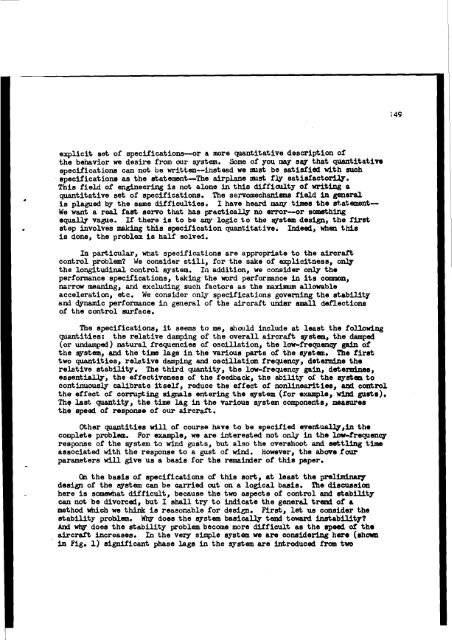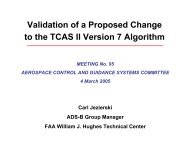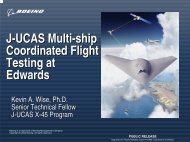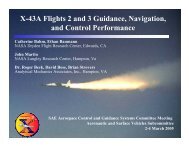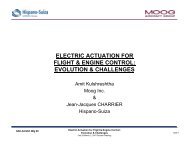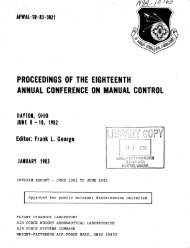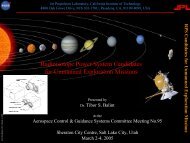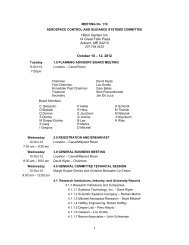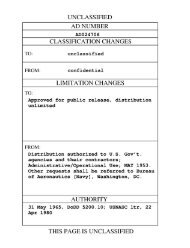Report of the Second Piloted Aircraft Flight Control System - Acgsc.org
Report of the Second Piloted Aircraft Flight Control System - Acgsc.org
Report of the Second Piloted Aircraft Flight Control System - Acgsc.org
You also want an ePaper? Increase the reach of your titles
YUMPU automatically turns print PDFs into web optimized ePapers that Google loves.
explicit set <strong>of</strong> specifications-or a more quantitative description <strong>of</strong><br />
<strong>the</strong> behavior we desire from our system. Some <strong>of</strong> you ~lvyr say that quantitative<br />
specificstiona can not be written--instead we nust be satisfied with euch<br />
specifications as <strong>the</strong> statement-The airplane mst fJy satisfactorily.<br />
This field <strong>of</strong> engineering is not alone in this difficulty <strong>of</strong> writing a<br />
cpantitative set <strong>of</strong> specifications. The seruomechaniem field in general<br />
is plagued by <strong>the</strong> same difficulties. I have heard maqy tin108 <strong>the</strong> et,atemsnt--<br />
We want a real fast servo that has practically no aror--or somuthing<br />
equally vague. If <strong>the</strong>re is to be logic to <strong>the</strong> eyetom design, <strong>the</strong> first<br />
step involves making this specification quantitative. Indeed, when this<br />
is done, <strong>the</strong> problem is half solved.<br />
In particular, what specifications are appropriate to <strong>the</strong> aircrai"t<br />
control problem? We consider still, for <strong>the</strong> sake <strong>of</strong> explicitness, only<br />
<strong>the</strong> longitudinal control system. 1i-1 addition, we consider on.<br />
<strong>the</strong><br />
performance specifications, taking <strong>the</strong> word performance in its conmon,<br />
narrow meaning, and excluding such factors as <strong>the</strong> maxhm~ allowable<br />
acceleration, etc. We consider only specifications governing <strong>the</strong> etabillty<br />
and dynamic performance in general <strong>of</strong> <strong>the</strong> aircraft undsr small daflections<br />
<strong>of</strong> <strong>the</strong> control wface.<br />
The specifications, it seems to me, should include at least <strong>the</strong> following<br />
quantities: <strong>the</strong> relative damping <strong>of</strong> <strong>the</strong> overall aircraft system, <strong>the</strong> damped<br />
(or undam~al) natural frequencies af oscillation, <strong>the</strong> low-frequency gaia <strong>of</strong><br />
<strong>the</strong> system, and <strong>the</strong> thm lags in <strong>the</strong> various parts <strong>of</strong> <strong>the</strong> system. The firat<br />
two quantities, relative damping and oscillation frequency, dot elmine <strong>the</strong><br />
relative stability . The third quantity, <strong>the</strong> low-f requency gain, datemines,<br />
essentially, <strong>the</strong> effectiveness <strong>of</strong> <strong>the</strong> feedback, <strong>the</strong> abillty <strong>of</strong> <strong>the</strong> systan to<br />
continuously calibrate itself, reduce <strong>the</strong> effect <strong>of</strong> nonlinearities, aDd control<br />
<strong>the</strong> effect <strong>of</strong> corrupting signals entering <strong>the</strong> system (for example, wind gusts).<br />
Thg last quantity, <strong>the</strong> time lag In <strong>the</strong> various system components, measures<br />
<strong>the</strong> speed <strong>of</strong> response <strong>of</strong> our alrcraft.<br />
O<strong>the</strong>r quantities will <strong>of</strong> course have to be specified qventuaUy,in <strong>the</strong><br />
complete problem. For example, we are interested not only In <strong>the</strong> low-frequency<br />
responee <strong>of</strong> <strong>the</strong> system to wind gusts, but also <strong>the</strong> overshoot and sattlhg timb<br />
associated with <strong>the</strong> response to a gust <strong>of</strong> wind. However, <strong>the</strong> above four<br />
parameters will give us a basis for <strong>the</strong> remainier <strong>of</strong> this paper.<br />
Ql <strong>the</strong> bade <strong>of</strong> specifications <strong>of</strong> this sort, at least <strong>the</strong> prelhhaxy<br />
design <strong>of</strong> <strong>the</strong> syetm can be aarried out on a logical basis. The dismssion<br />
here is samewhat difficult, because <strong>the</strong> two aepecte <strong>of</strong> control and stability<br />
can not be divorced, but I shall try to indicate <strong>the</strong> general tra <strong>of</strong> a<br />
method which we think is reasonable for design. Mrst, let us consider <strong>the</strong><br />
stability problem. does <strong>the</strong> system basically tend toward instability?<br />
And does <strong>the</strong> stability problem become more difficult as <strong>the</strong> speed <strong>of</strong> <strong>the</strong><br />
aircraft increases. In <strong>the</strong> very simple system we are conaideriag here (shown<br />
' in Fig. 1) significant phase lags In <strong>the</strong> system are introduced from two


